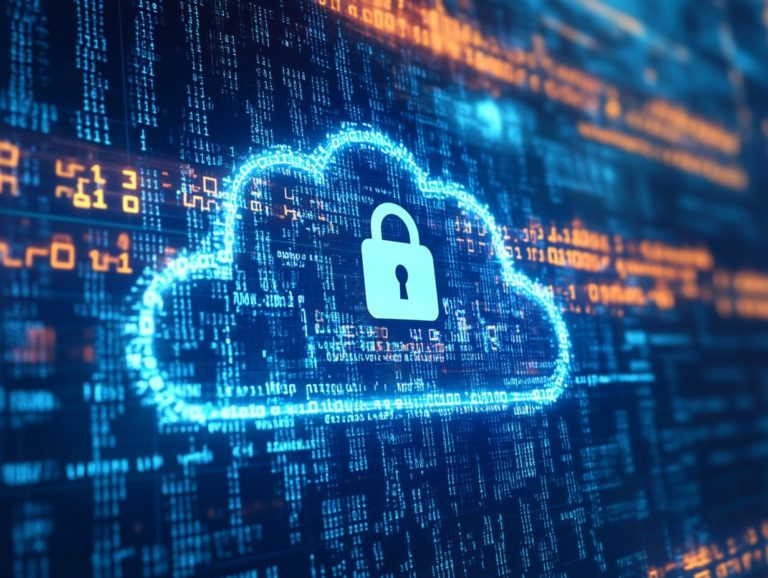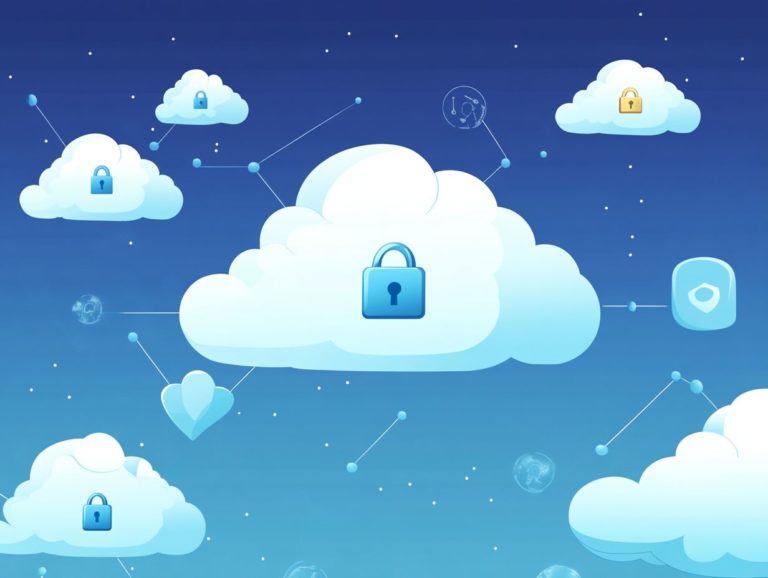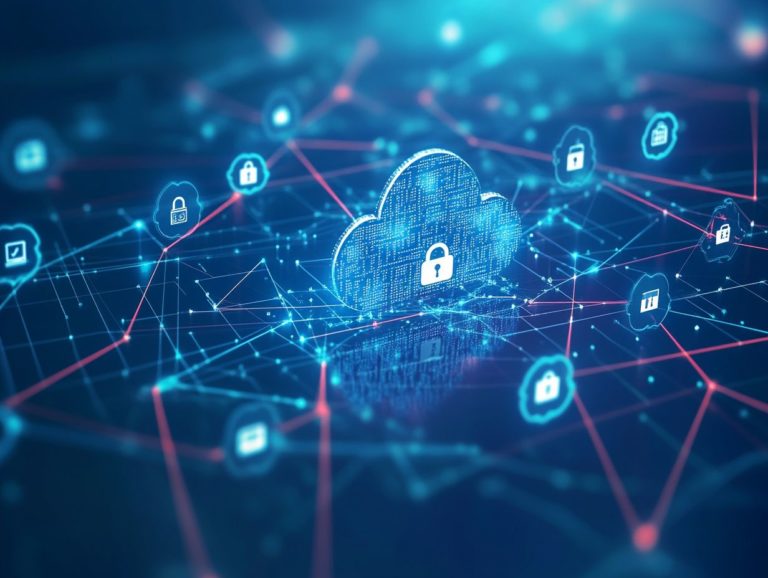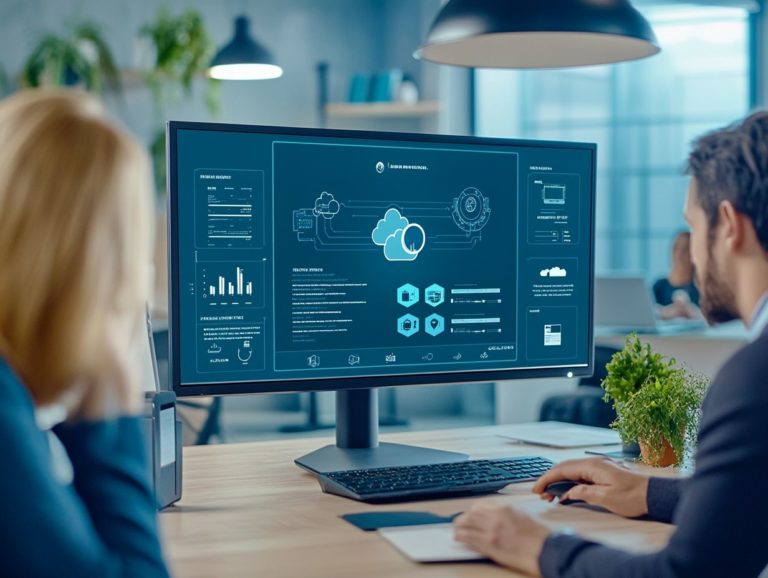The Benefits of Continuous Monitoring for Cloud Security
As businesses increasingly depend on cloud computing, grasping and addressing the associated risks is essential for your success.
This article delves into the critical importance of cloud security, emphasizing continuous monitoring as a pivotal strategy for protecting your sensitive data.
You will explore what continuous monitoring entails, the advantages it brings in enhancing threat detection and compliance, and the best practices for its effective implementation.
By the end, you will gain valuable insights into how continuous monitoring can substantially strengthen your cloud security posture.
Contents
Key Takeaways:

Continuous monitoring is crucial for maintaining strong cloud security by providing real-time threat detection and response. With continuous monitoring, organizations can have better visibility and control over their cloud environments, leading to an enhanced security posture. Implementing continuous monitoring not only helps with compliance and regulatory requirements but also saves time and resources in the long run.
The Importance of Cloud Security
In today s digital landscape, cloud security stands as a cornerstone for any business relying on cloud environments for its IT infrastructure.
You must prioritize the integrity, confidentiality, and availability of your data housed in the cloud to fend off security threats and data breaches while ensuring compliance with legal regulations.
With the rise of cloud-native applications, the need for robust security protocols becomes even more critical. This safeguards sensitive information from unauthorized access and cyber-attacks.
Understanding the Risks of Cloud Computing
The risks associated with cloud computing are both diverse and complex, presenting potential security threats that could lead to data breaches and operational disruptions.
In today s ever-evolving cyber landscape, it s essential for you to recognize these risks in order to implement effective cloud security measures.
Unauthorized access can result in sensitive information slipping into the hands of malicious actors, jeopardizing customer trust and tarnishing your business reputation.
Additionally, data loss may occur due to hardware failures or software bugs, which can significantly disrupt operational continuity and lead to financial setbacks.
Service outages pose yet another challenge, potentially derailing your business operations and resulting in lost revenue and dissatisfied customers.
Given these challenges, it is crucial for your success to adhere to established security policies and best practices, ensuring that both data integrity and availability are upheld in the cloud environment.
Continuous Monitoring: What is it and Why is it Important?

Continuous monitoring means keeping a close watch on your cloud systems to catch problems quickly. It represents a comprehensive strategy designed to uphold the security and performance of your IT systems.
By helping to spot threats in real time, this proactive approach ensures that you can swiftly identify security incidents as they arise.
It also automates alerts and responses to effectively mitigate risks, ultimately bolstering the integrity of your systems.
Definition and Purpose of Continuous Monitoring
Continuous monitoring involves the ongoing observation and analysis of your IT systems and cloud environments to spot anomalies, security threats, and compliance issues in real time.
By utilizing advanced monitoring tools and visibility metrics, you can effectively enforce security policies and ensure proactive risk management.
This process doesn t just aim to detect irregularities quickly; it also provides you with a structured framework to maintain compliance with industry standards like ISO 27001 and GDPR.
By employing methodologies such as automated alerting, data aggregation, and trend analysis, continuous monitoring gives your teams the power to swiftly address potential risks and refine their security posture.
Integrating this approach into your operational workflows enhances your responsiveness to emerging threats, allowing you to gain a competitive edge while safeguarding your assets.
Benefits of Continuous Monitoring for Cloud Security
Implementing continuous monitoring in cloud security brings a wealth of advantages, such as better detection of threats, enhanced real-time visibility, and a more streamlined approach to meeting rules and regulations.
By consistently analyzing network traffic and user behavior, you can significantly bolster the protection of your data and IT systems against the ever-changing landscape of security threats.
Improved Threat Detection and Response

One of the primary advantages of continuous monitoring is its remarkable ability to enhance threat detection and response mechanisms within your cloud security frameworks. Utilizing real-time data analysis and automated alerts allows you to swiftly identify security incidents and initiate an effective incident response, significantly minimizing the impact of potential breaches.
This proactive approach gives you the power to stay ahead of evolving cyber threats by actively searching for signs of cyber threats. By seeking out vulnerabilities and indicators of compromise, you can uncover malicious activities that traditional detection methods might overlook.
Integrating robust incident response strategies ensures a streamlined workflow when responding to alerts, allowing for timely and coordinated actions. These innovative practices cultivate a more resilient security posture, instilling confidence in the integrity and availability of your organizational data amid an increasingly complex threat landscape.
Real-time Visibility and Control
Real-time visibility into cloud environments is essential for effective security management. It allows you to monitor network traffic, identify performance issues, and optimize resource allocation.
This level of control is made possible by advanced monitoring tools that offer comprehensive insights into system performance and security postures. By utilizing these tools, you can swiftly detect anomalies and potential threats, ensuring that you respond promptly to security incidents before they escalate.
Gaining a clear view of data flows helps you pinpoint performance bottlenecks that might hinder operations, allowing your team to take corrective actions that enhance overall system efficiency. This proactive approach improves resource utilization and ensures compliance with regulatory requirements, protecting sensitive information.
Ultimately, harnessing real-time visibility transforms your cloud security into a more dynamic and resilient framework, fostering innovation and bolstering confidence in your cloud-based operations.
Compliance and Regulatory Requirements
Continuous monitoring is essential for meeting compliance and regulatory requirements, ensuring that security policies are effectively enforced across your cloud environments.
By leveraging continuous monitoring, you can conduct regular audits, perform risk assessments, and maintain adherence to compliance standards. This ongoing vigilance allows you to identify potential vulnerabilities and evaluate the effectiveness of your existing controls, empowering you to respond proactively to emerging threats.
Integrating continuous monitoring into your risk management processes not only guarantees compliance with regulations but also enhances transparency for your stakeholders. Having robust security policies in place lays the groundwork for these monitoring efforts, enabling you to address issues promptly before they escalate.
The interplay of continuous monitoring and risk assessment significantly strengthens your ability to navigate complex compliance landscapes while fostering a culture of security awareness throughout your organization.
Implementing Continuous Monitoring for Cloud Security

Implementing continuous monitoring for cloud security is a strategic initiative that requires you to deploy advanced monitoring solutions, adhere to best practices, and employ effective data management techniques.
In hybrid environments, where multiple cloud services and on-premises systems interact seamlessly, the significance of a cohesive monitoring strategy becomes paramount. This approach enhances security and ensures that you maintain a comprehensive view of your entire ecosystem.
Key Considerations and Best Practices
When implementing continuous monitoring for cloud security, keep key factors in mind for effective outcomes.
Start by setting strong security rules and using automated processes to boost efficiency. Clearly define roles to foster accountability among your team.
Integrating advanced security tools streamlines monitoring, allowing for real-time threat detection. Regularly updating your security policies boosts resilience and aligns you with changing compliance needs.
This constant vigilance helps quickly identify and fix vulnerabilities, protecting sensitive data and maintaining trust with stakeholders.
The Value of Continuous Monitoring for Cloud Security
Continuous monitoring is crucial. It enhances threat detection, supports proactive risk management, and implements strong security solutions.
Investing in continuous monitoring allows your organization to navigate cloud complexities, protecting assets from potential threats.
Real-time monitoring helps you swiftly spot unusual activities, reducing security breach risks. This vigilance allows you to address critical vulnerabilities immediately.
The data generated from continuous monitoring is invaluable for improving security protocols and responding to new threats. This approach strengthens defenses and fosters a culture of ongoing vigilance essential for effective risk management in today s digital landscape.






